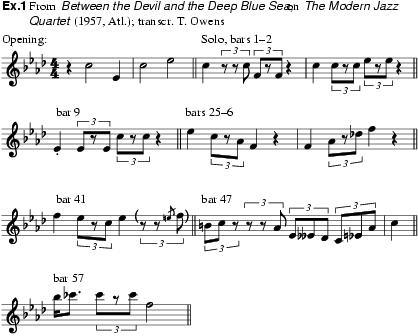
(b LaGrange, IL, 3 May 1920). American jazz pianist and composer. He grew up in Albuquerque, New Mexico, where he began to learn the piano at the age of seven. His musical studies continued at the University of New Mexico. In 1946, with fellow black musician Kenny Clarke, he joined Dizzy Gillespie’s bop-style big band in New York. Further studies at the Manhattan School of Music, which led to a master’s degree in 1953, were interrupted in 1948 when the band made a concert tour of Europe. After returning to the USA, Lewis worked for Lester Young, Charlie Parker, Miles Davis, Gillespie, Illinois Jacquet and Ella Fitzgerald. He made some notable recordings with Parker, among them Parker’s Mood (1948, on the album The Genius of Charlie Parker, Savoy) and Blues for Alice (1951, on Charlie Parker, Clef).
In 1951–2 Lewis served as the pianist with the Milt Jackson Quartet; by the end of 1952 this group was renamed the Modern jazz quartet, with Lewis as its musical director. For the next two decades his musical activity centred on the MJQ, for which he wrote many pieces. From 1958 to 1982 he was also music director of the annual Monterey Jazz Festival, and during the late 1950s he was head of faculty for the summer clinics at the Lenox School of Jazz. He also formed the cooperative big band Orchestra USA, which performed and recorded third-stream compositions (1962–5). After the MJQ disbanded temporarily in 1974, Lewis held teaching positions at the City College of New York and at Harvard University. By the early 1980s he was performing with the reunited MJQ and with a sextet, the John Lewis Group, and in 1985, with Gary Giddins and Roberta Swann, he founded the American Jazz Orchestra, which performed until the end of 1992.
Lewis is among the most conservative of bop pianists. His improvised melodies, played with a delicate touch, are usually simple and quiet; the accompaniments are correspondingly light, with Lewis’s left hand often just grazing the keys to produce a barely audible sound. His method of accompanying soloists is similarly understated: he often plays simple countermelodies in octaves which combine with the solo and bass parts to form a polyphonic texture. Occasionally Lewis plays in a manner resembling the stride styles of James P. Johnson and Fats Waller, all the while retaining his light touch.
Many of Lewis’s solos have a degree of motivic unity which is rare in jazz. For example, his 64-bar solo in Between the Devil and the Deep Blue Sea (1957, on the album The Modern Jazz Quartet, Atl.) derives almost entirely from its first two bars, which in turn derive from the first four notes of the theme (ex.1). As the solo progresses Lewis subjects its opening motif to inversion (bar 9), chromatic alteration (bars 47 and 57) and a variety of other alterations in pitch and shape (bars 25–6, 41), which nevertheless retain their links with the basic figure.

Lewis is similarly conservative as a composer, for his music draws heavily on harmonic and melodic practices found in 18th-century European compositions. Since the 1950s he has written a number of third-stream works combining European compositional techniques and jazz improvisation. Most of these were composed for the MJQ, or for the quartet with instrumental ensembles of various sizes, and are published by MJQ Music. Among his best pieces for the MJQ are Django, the ballet suite The Comedy (1962, Atl.), and especially the four pieces Versailles, Three Windows, Vendome and Concorde, all of which combine fugal imitation and non-imitative polyphonic jazz in highly effective ways.
(selective list)
|
Django (from Modern Jazz Quartet; 1954–5, Prst.); Versailles (from Fontessa; 1956, Atl.); Three Windows (from One Never Knows; 1957, Atl.); Sketch for Double String Quartet, Exposure (from Third Stream Music; 1957, 1959–60, Atl.); England’s Carol (from The Modern Jazz Quartet and Orchestra; 1960, Atl.); Vendome (from European Concert; 1960, Atl.); Concorde (from A Quartet is a Quartet is a Quartet; 1963, Atl.); Three Little Feelings (from Orchestra U.S.A.; 1963, Colpix); Mirjana of my Heart and Soul (from P.O.V.; 1975, Col.) |
N. Hentoff: John Lewis (New York, 1960)
M. James: Ten Modern Jazzmen (London, 1960), 65–80
G. Schuller: ‘John Lewis on the Modern Jazz Beachhead’, High Fidelity, x/10 (1960), 54–5, 134–5
F. Thorne: ‘An Afternoon with John Lewis’, JR, iii/3 (1960), 6–9
R.J. Gleason: Celebrating the Duke, and Louis, Bessie, Billie, Bird, Carmen, Miles, Dizzy, and other Heroes (Boston, 1975)
L. Feather: The Pleasures of Jazz: Leading Performers on their Lives, their Music, their Contemporaries (New York, 1976)
T. Owens: ‘The Fugal Pieces of the Modern Jazz Quartet’, Journal of Jazz Studies, iv/1 (1976), 25–46
C.J. Stuessy: The Confluence of Jazz and Classical Music from 1950 to 1970 (diss., Eastman School, 1978), 348, 402
L. Lyons: The Great Jazz Pianists: Speaking of their Lives and Music (New York, 1983), 75–82
F. Davis: ‘Back in Time (John Lewis)’, In the Moment: Jazz in the 1980s (New York, 1986), 227–37
W. Knauer: Zwischen Bebop und Free Jazz: Komposition und Improvisation des Modern Jazz Quartet (Mainz, 1990)
T. Lalo: John Lewis (Montelimar, 1991) [incl. discography by J. Lubin and Lalo]
M. Bourne: ‘Bop Baroque the Blues’, Down Beat, lix/1 (1992), 24–7 [incl. discography]
THOMAS OWENS